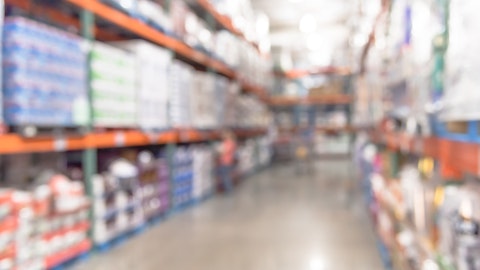So I think we expect to continue to grow and outgrow most of the industry. And obviously, there will be some headwinds in the way, but we think our investments were the right investments, and we expect to get rewarded.
Andrew Wolf: Great. I appreciate that. Can I just ask one other question? It’s not really a follow-up. You haven’t mentioned labor productivity, I think, or I didn’t hear it at least, where I know in the past quarters, it sounded like you felt pretty good about it. So can you just give us an update how are you feeling about hiring, training, turnover, labor productivity? And where — I think you mentioned you’re going to invest in some automated picking. I know that’s longer term, it’s sort of a separate thing, but where that fits into, I guess, your cost structure going — long-term cost structure?
Chris Pappas: Yes. It’s still people, process, product. People are — they’re our greatest asset, and we keep investing and trying to make it a great place to work. And it’s always challenging. Obviously, COVID was a new level of the word challenging, but I think we’re getting more and more productive. I think the team, especially in the new areas we’ve invested in, it’s — it will continue to get better as training, we’ve invested in more and more into training. I think you have to. You have a lot of new people coming into the industry. I would say nobody really graduates school and comes out and says, I really want to go into food service, right? So it’s not like you’re looking for accountants or doctors or bankers. It’s people that are — we hire a lot out of the industry in sales.
We have a lot of chefs that work for us that have changed careers. But in a lot of the other positions, it’s people that are coming in to the industry, and you have to train them and you have to make sure that you make it a great place to work because we want them to stay because it does take years for them to get better and better at their job. No matter how much technology you have, we are in the people business. So always a headwind, but it’s what we do, and we think we do it really well and we continue to get more productive.
Jim Leddy: Andy, I’ll just add that when we talk about our 5-year plan and getting operating leverage gradually increasing as we go through the next 2 to 5 years, a big part of that is the impact on rationalizing labor and labor costs through consolidating facilities like we’re doing on the — in Northern California, we’re doing in Florida now. We’re doing in Texas, New England, consolidating routes as part of those facility consolidations. And then the tech-related process improvements are really focused on error reduction and a lot on inventory management. And so I think our operating teams and our procurement teams are doing a great job of starting that. And hopefully, we get more benefit from it down the road as well.
Operator: The next question comes from Kelly Bania with BMO Capital.
Kelly Bania: Jim, we’re starting to touch on this a little bit, but just was curious if you can update us on the pace and the cost of those facility expansions, whether it be Northern California or some of the others that you have going on. Are those coming time wise and expense wise on plan and any changes to that outlook for this year?
Jim Leddy: No real changes to the outlook. I think we have a little bit of front-loaded CapEx in the first half of the year as we finish the — our building in Northern California, and we expect in a few weeks to start the phased-in consolidation of 4 separate facilities. I think as we mentioned in our prepared remarks, we expect most of the cost savings and efficiencies to really emerge in 2025 because we’re going to spend the rest of this year really in a very thoughtful phased-in consolidation, just managing the logistics and servicing the customers through that process. We finished most of the consolidation in Florida. So from an OpEx perspective, I’ll just go back to what I stated earlier. Most of the impact from a year-over-year perspective is in the first half of the year as we lap those increased rents that we had last year will — the year-over-years will — we expect to get better.
That’s assuming, of course, top line and gross profit hold up accordingly per our guidance and per our plan. So I think, look, we’ll get the bulk of the benefit really starting in the latter part of this year and then into ’25 and then into ’26. So it’s really setting us up for the next couple of years in terms of generating operating leverage.
Kelly Bania: Great. Can you also just touch a little bit more on the seasonality trends that you’re seeing? It sounds like the spring has really trended as expected or maybe a little bit better, but there’s always a lot of moving parts in the spring. So just help us understand what you’re seeing so far? And any real divergences among geographies that might be of note?
Jim Leddy: Well, I think the only thing we would mention is, with the early Easter, there was a little bit of noise around the last week of March and the first week of April, but nothing like hugely material that we would necessarily call out. And then the rest of April, started to build back to where we expected or very close to where we expected. I don’t think we see anything going into the summer. Hopefully, we don’t have the kind of volatility or significant international travel impact that we had last summer, but obviously, we can’t predict that right now. So I wouldn’t say there’s anything that we would call out right now seasonally other than the — as we talked about earlier, there’s always concerns about the macroeconomic environment that we’re hearing a lot about.
Kelly Bania: Okay. That’s helpful. And just another one on this SKU count. Obviously, there’s been a lot of acquisitions and expansions into new categories, but the SKUs are up to 70,000, I believe, now. What’s the right number over time? How do you make sure to balance that selection and with the complexity of having more and more SKUs? Just any thoughts on that?
Chris Pappas: Yes. Well, the SKUs is — again, you got to be very careful. It’s a little misleading sometimes because it’s kind of like the 80-20 rule. I mean it’s — 80% of the business is in 20% of the SKUs. So we run a huge just-in-time process because of our independent customer base, it puts a tremendous demand on being able to accommodate a lot of the creativity that the people that run these restaurants demand of us. And I think that’s one of the things that we are probably the best in the industry because we kind of understand it. We’ve been doing it for so long. So I think as we get bigger and we expand more territories and more categories, I think that proliferates a lot of the amount of SKUs that come through the system.




